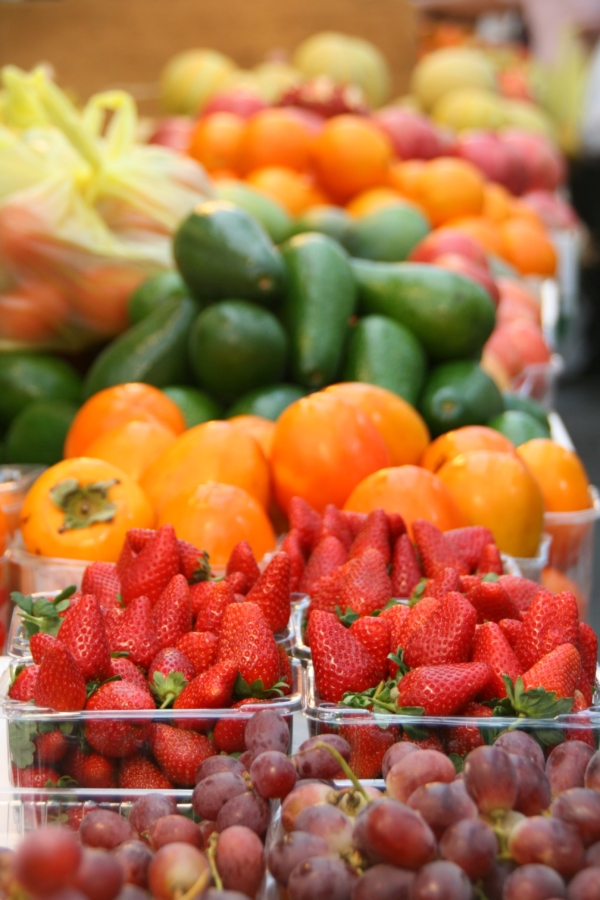Sugar And the Immune System
How Much Can I Eat?


Contributed by
Dr. Natalie
Kazzi Buxton
DrPH, MS, RD
Sugar is an essential component for our body. Glucose, a simple sugar, is the energy source that our cells need in order to function. Yet too much sugar is not good for us, which is why we have to pay attention to the sources that we get it from. While most of us know that eating candy and other sweets is bad for our teeth, consuming foods that have a high density of refined carbohydrates or straight up consuming processed sugar can be detrimental to our immune system.
Sugar’s Effect on the Immune System
Our immune system is the first line of defense against microbes that can hurt us. When harmful microbes evade barriers such as skin, stomach acid, or mucous, the next line of defense that we have are white blood cells. These cells eat up microbes and thus destroy them. A research study done on human participants at Loma Linda University, and published in the 1970s, showed that the ability of white blood cells to engulf bacteria greatly decreased after people consumed different types of sugar. The effects of the decrease in this form of immunity lasted up to 5 hours after eating the sugary product (1). Another study done in mice showed how sugar could predispose mice to develop allergic reactions in their lungs (2) and another fairly recent study showed how high sugar diets increased inflammation and altered the immune response in flies (3).
The negative effect of sugar on the immune system of humans happens when we eat refined sugar and simple carbohydrates in large amounts. Under normal physiologic conditions, our blood sugar levels spike when we eat a large amount of sugar. To bring blood sugar levels back to normal, our body releases insulin, which is a hormone that stimulates our cells to absorb sugar and take it out of the blood stream. Too much sugar in the blood for long periods of time eventually makes our cells “worn out” to the point that they don’t respond to the insulin anymore and blood sugar levels remain high. This is insulin resistance which causes diabetes type 2. Counsel is given to diabetics to keep their blood sugar under control because “patients with uncontrolled diabetes are considered immunosuppressed due to the negative effects of elevated blood sugars on the immune system. Hyperglycemia impairs overall immunity through different mechanisms (4). In addition, the more sugar we eat the more fat-tissue we will gain and “inflammation activated by the immune system in obese people can lead to insulin resistance” (5) so there are added components that can lead to this dire outcome. If we are looking for ways to support our immune system, avoiding sweets is a good idea; practicing abstemiousness is encouraged.
Prevalence of Sugar in Foods
I am not saying we should cut out all sugar from our diet. Let’s first admit that sugar is a wonderful product. It’s basically magic powder that makes everything taste good. Again, the cells in our body need glucose for energy. Whole wheat bread, rice, cereals, fruits, nuts and legumes all contain carbohydrates which our body breaks down into sugar to be used as energy. Sugar that comes from whole foods is good for us, but refined carbohydrates and sugar that is processed and added to foods is what we need to look out for. In the 1980s, public health campaigns made fat the one product to avoid in order to be healthy, especially heart healthy. People started reading labels on processed products to avoid ‘bad’ fat and companies revamped their recipes to cut out most of the fat. But in order to keep the taste yummy and calories tolerable enough for people to still buy their product, they upped the sugar and carbohydrate levels. This even happened to salty snacks. What was now labeled as “fat free” had more sugar to compensate and maintain taste. Sugar was the secret ingredient that saved marketing and sales. Thirty years later, the general public has come to realize that sugar is actually the culprit of the health outcomes that we tried to avoid and that certain fats are actually very good for us (6).
In the 1970s it was estimated that the average American ate 123 pounds of sugar per year. A more recent calculation is that the average American now eats about 152 pounds of sugar in one year (7), which is a little less than 1 cup of sugar per day! It’s numbers like these that correlate with a myriad of health problems.
How to Look Out for Sugar in Processed Foods
Since sugar is in most processed foods and admittedly a lot of processed foods are difficult to avoid, I’ll share a few tips on what to look out for.
- The first tip is to watch out for products that say something like ‘now fat free’ or ‘50% less fat’ because they often have sugar added to them.
- The second tip is to scan through the ingredients list. The order in which ingredients appear is based on its quantity present in the product with the first ingredient having the greatest quantity and the last ingredient having the least quantity. If sugar is unexpectedly one of the first 3 ingredients, watch out.
- The third tip is related, in that when reading the ingredients look out for other names of sugar. If there are multiple ‘sugar’ ingredients (8), watch out. I once read the ingredient list of a cereal that listed sugar as the second, corn syrup as the fifth, and brown sugar syrup as the eighth ingredient out of a total of 10 ingredients.
- If you really want to become savvy about checking the nutrition label, the final tip is to check the total carbs per serving, under which you’ll see a section for added sugars (usually directly above Protein). This amount is present in grams and generally, women should not have more than 25 grams (6 teaspoons) of sugar a day and men, who can get away with more, should limit their intake to a maximum of 38 grams (9 teaspoons) of sugar per day (9).
I’m into nutrition and I like to read nutrition labels and I encourage people to do it, but I realize that not many people will likely do it. Yet they are interested in being proactive to reduce the amount of sugar they eat. So, to put it simply, moderation is key. Ellen White endorsed moderation when it came to sweets. “Plain, simple pie may serve as dessert, but when one eats two or three pieces merely to gratify an inordinate appetite, he unfits himself for the service of God. Some, after partaking largely of other food, will take dessert, not because they need it, but because it tastes good. If they are asked to take a second piece, the temptation is too great to be resisted, and two or three pieces of pie are added to the load placed upon the already overworked stomach. He who will do this has never educated himself to practice self-denial. The victim of appetite is so wedded to his own way that he cannot see the injury he is doing to himself.” (10).
If you have a piece of dessert after a meal, enjoy it. Munch on that cookie and enjoy that cake, but do so in moderation and self-control. If it looks like you eat more sweets than you do fruits and vegetables, there’s a problem, especially for our immune system. A large review of scientific literature suggested that “higher intakes of fruit and vegetables lead to both a reduction in proinflammatory mediators and an enhanced immune cell profile” (11). Think about it like this, there are studies that say sugar can have a negative impact on components of your immune system and other studies that say fruits and vegetables have a positive effect on your immune system, so it’s logical to conclude that if you eat more of what helps your immune system than what doesn’t help it, you’re on the right track.

References
- Sanchez, A., Reeser, J. L., Lau, H. S., Yahiku, P. Y., Willard, R. E., McMillan, P. J., … & Register, U. D. (1973). Role of sugars in human neutrophilic phagocytosis. The American journal of clinical nutrition, 26(11), 1180-1184.
- Kierstein, S., Krytska, K., Kierstein, G., Hortobágyi, L., Zhu, X., & Haczku, A. (2008). Sugar consumption increases susceptibility to allergic airway inflammation and activates the innate immune system in the lung. Journal of Allergy and Clinical Immunology, 121(2), S196.
- Yu, S., Zhang, G., & Jin, L. H. (2018). A high-sugar diet affects cellular and humoral immune responses in Drosophila. Experimental cell research, 368(2), 215-224.
- http://www.diabetesincontrol.com/diabetes-mellitus-and-infectious-diseases-controlling-chronic-hyperglycemia/
- Patel, P. S., Buras, E. D., & Balasubramanyam, A. (2013). The role of the immune system in obesity and insulin resistance. Journal of obesity, 2013.
- La Berge, A. F. (2008). How the ideology of low fat conquered America. Journal of the History of Medicine and Allied Sciences, 63(2), 139-177.
- https://www.virtahealth.com/blog/names-for-sugar
- https://www.dhhs.nh.gov/dphs/nhp/documents/sugar.pdf
- https://www.heart.org/en/healthy-living/healthy-eating/eat-smart/sugar/added-sugars
- Ellen G. White, Letter 17, 1895 (CD 333.5).
- Hosseini, B., Berthon, B. S., Saedisomeolia, A., Starkey, M. R., Collison, A., Wark, P. A., & Wood, L. G. (2018). Effects of fruit and vegetable consumption on inflammatory biomarkers and immune cell populations: a systematic literature review and meta-analysis. The American Journal of Clinical Nutrition, 108(1), 136-155.


I’m so thankful for this information and the resources that you have provided on this web site. I prompted to speak on Sugar for Health and Temperance this week at church; and was praying to find information that is given by our church organization. I’m new at this and was led to this site that has so much wonderful information. I was thinking about doing a program for alcohol addiction and wha la it’s here. Everything I need becauue The Lord said He would supply all your need according to his riches in glory through Christ Jesus Praise The Lord. Christ Blessings to You All
Thank you for your encouraging comment, Tracey! We are praying that the information and resources on this site will be relevant and useful. We praise God that prayers are being answered by our work — all to His glory! Blessings to you in your ministry.
Thank you for the information, I needed to read this information and return back to healthy eating. This is the worst time of the year for me. I am praying for God to help me with self control and temperance. Thanks for the support.
Thank you for sharing Shirlee! Your message is encouraging to me we want to do a focus on healthy eating for next year. You’ve given me inspiration to move forward on some of our plans for this. Thank you so much for sharing. I have just sent up a prayer for you. God has all the strength you need to get you through this time…and we are here to walk the road with you. Blessings on your journey!
[…] and eat more carbs to boost their energy again. As you can see, this can quickly become a habit. Adventist HealthyYOU cited a few different studies about sugar and the role it plays in our immune system. White blood […]
Sugar is not a “magic powder that makes everything taste good”. I detest the extremely overabundance of added sugar – even in ‘health foods’. It’s an irrational practice. Many ‘health foods’ have sugar as the first ingredient! I savor the natural sweetness even in grains. The history of sugar is not pretty. There is absolutely no rational reason to add so much of this. Most of humanity, at least in the ‘developed’ world has been polluted with the excessive amount of it that they’ve become addicted to it.
[…] amounts of sugar can lower your immune system. Sugar is actually part of the reason we’re all so sick over the holidays. Lowered immune […]
[…] Sugar And the Immune System […]